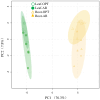A Preliminary Study on the Whole-Plant Regulations of the Shrub Campylotropis polyantha in Response to Hostile Dryland Conditions
- PMID: 39330502
- PMCID: PMC11433755
- DOI: 10.3390/metabo14090495
A Preliminary Study on the Whole-Plant Regulations of the Shrub Campylotropis polyantha in Response to Hostile Dryland Conditions
Abstract
Drylands cover more than 40% of global land surface and will continue to expand by 10% at the end of this century. Understanding the resistance mechanisms of native species is of particular importance for vegetation restoration and management in drylands. In the present study, metabolome of a dominant shrub Campylotropis polyantha in a dry-hot valley were investigated. Compared to plants grown at the wetter site, C. polyantha tended to slow down carbon (C) assimilation to prevent water loss concurrent with low foliar reactive oxygen species and sugar concentrations at the drier and hotter site. Nitrogen (N) assimilation and turn over were stimulated under stressful conditions and higher leaf N content was kept at the expense of root N pools. At the drier site, roots contained more water but less N compounds derived from the citric acid cycle. The site had little effect on metabolites partitioning between leaves and roots. Generally, roots contained more C but less N. Aromatic compounds were differently impacted by site conditions. The present study, for the first time, uncovers the apparent metabolic adaptations of C. polyantha to hostile dryland conditions. However, due to the limited number of samples, we are cautious about drawing general conclusions regarding the resistance mechanisms. Further studies with a broader spatial range and larger time scale are therefore recommended to provide more robust information for vegetation restoration and management in dryland areas under a changing climate.
Keywords: carbohydrates; climate change; drought; drylands; metabolome; nitrogen; partitioning; roots.
Conflict of interest statement
The authors declare no conflicts of interest.
Figures





Similar articles
-
[Effects of environmental stress on seedlings root growth and nodulation of leguminous shrubs in the dry valley of Minjiang River].Ying Yong Sheng Tai Xue Bao. 2009 Aug;20(8):1825-31. Ying Yong Sheng Tai Xue Bao. 2009. PMID: 19947198 Chinese.
-
Soil organic carbon in drylands: shrub encroachment and vegetation management effects dwarf those of livestock grazing.Ecol Appl. 2020 Oct;30(7):e02150. doi: 10.1002/eap.2150. Epub 2020 May 26. Ecol Appl. 2020. PMID: 32343858
-
Greater increases in China's dryland ecosystem vulnerability in drier conditions than in wetter conditions.J Environ Manage. 2021 Aug 1;291:112689. doi: 10.1016/j.jenvman.2021.112689. Epub 2021 May 5. J Environ Manage. 2021. PMID: 33962289
-
Nature-based framework for sustainable afforestation in global drylands under changing climate.Glob Chang Biol. 2022 Apr;28(7):2202-2220. doi: 10.1111/gcb.16059. Epub 2022 Jan 14. Glob Chang Biol. 2022. PMID: 34953175 Review.
-
Dryland mechanisms could widely control ecosystem functioning in a drier and warmer world.Nat Ecol Evol. 2022 Aug;6(8):1064-1076. doi: 10.1038/s41559-022-01779-y. Epub 2022 Jul 25. Nat Ecol Evol. 2022. PMID: 35879539 Review.
References
-
- Seneviratne S.I., Zhang X., Adnan M., Badi W., Dereczynski C., Luca A.D., Ghosh S., Iskandar I., Kossin J., Lewis S., et al. Weather and climate extreme events in a changing climate. In: Masson-Delmotte V.P., Zhai A., Pirani S.L., Connors C., editors. Climate Change 2021: The Physical Science Basis: Working Group I Contribution to the Sixth Assessment Report of the Intergovernmental Panel on Climate Change. Cambridge University Press; Cambridge, UK: 2021. pp. 1513–1766.
-
- Masson-Delmotte V.P., Zhai P., Pirani S.L., Connors C., Péan S., Berger N., Caud Y., Chen L., Goldfarb M.I., Scheel Monteiro P.M. Climate Change 2021: The Physical Science Basis. Contribution of Working Group I to the Sixth Assessment Report of the Intergovernmental Panel on Climate Change. Cambridge University Press; Cambridge, UK: New York, NY, USA: 2021. IPCC, 2021: Summary for Policymakers.
-
- Zhang J., Yang Z., Wang D., Zhang X. Climate Change and Causes in the Yuanmou Dry-Hot Valley of Yunnan, China. J. Arid Environ. 2002;51:153–162. doi: 10.1006/jare.2001.0851. - DOI
Grants and funding
LinkOut - more resources
Full Text Sources

